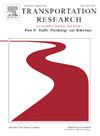Improving models of pedestrian crossing behavior using neural signatures of decision-making
IF 3.5
2区 工程技术
Q1 PSYCHOLOGY, APPLIED
Transportation Research Part F-Traffic Psychology and Behaviour
Pub Date : 2025-02-01
DOI:10.1016/j.trf.2025.01.047
引用次数: 0
Abstract
Understanding and modelling pedestrian behavior is important for traffic safety, not least in the context of vehicle automation. There exist competing models for how pedestrians decide if and when to cross a road with oncoming traffic. Distinguishing between these competing models is non-trivial, but recent results in the cognitive neuroscience of decision-making offer a promising method, complementing behavioral data with electroencephalography (EEG): Previous EEG studies have shown that the centro-parietal positive potential (CPP) reflects evidence accumulation during abstract perceptual decision-making tasks, and that it can be used to arbitrate between alternative models of these tasks. However, it is not yet known whether the CPP can be used to support modeling in more complex, embodied contexts, such as human locomotion in road traffic. Here, we address this question by designing an EEG paradigm for pedestrian road-crossing. In a computer-based experiment, participants made road-crossing decisions in a simulated scenario where a car approached them under different time-to-arrival (TTA) conditions. Three perception-based drift diffusion models and one utility-based drift diffusion model were used to model the pedestrian behavior. The behavioral data showed a partial preference for the utility-based model over the perception-based drift diffusion models. The EEG data showed a CPP signal, which helped distinguish between the models in a way that behavioral data alone could not: CPP amplitude was positively correlated with accumulated evidence in the drift–diffusion models, and with stronger correlations for the utility-based model than for the perception-based models. Our results show that the CPP signature can be used to help arbitrate between competing decision-making models also in more embodied tasks, a finding which has applied implications not least in the context of traffic safety engineering and vehicle automation.
求助全文
约1分钟内获得全文
求助全文
来源期刊
CiteScore
7.60
自引率
14.60%
发文量
239
审稿时长
71 days
期刊介绍:
Transportation Research Part F: Traffic Psychology and Behaviour focuses on the behavioural and psychological aspects of traffic and transport. The aim of the journal is to enhance theory development, improve the quality of empirical studies and to stimulate the application of research findings in practice. TRF provides a focus and a means of communication for the considerable amount of research activities that are now being carried out in this field. The journal provides a forum for transportation researchers, psychologists, ergonomists, engineers and policy-makers with an interest in traffic and transport psychology.

 求助内容:
求助内容: 应助结果提醒方式:
应助结果提醒方式:


